Boyle J.A. The Cambridge History of Iran, Volume 5: The Saljuq and Mongol Periods
Подождите немного. Документ загружается.

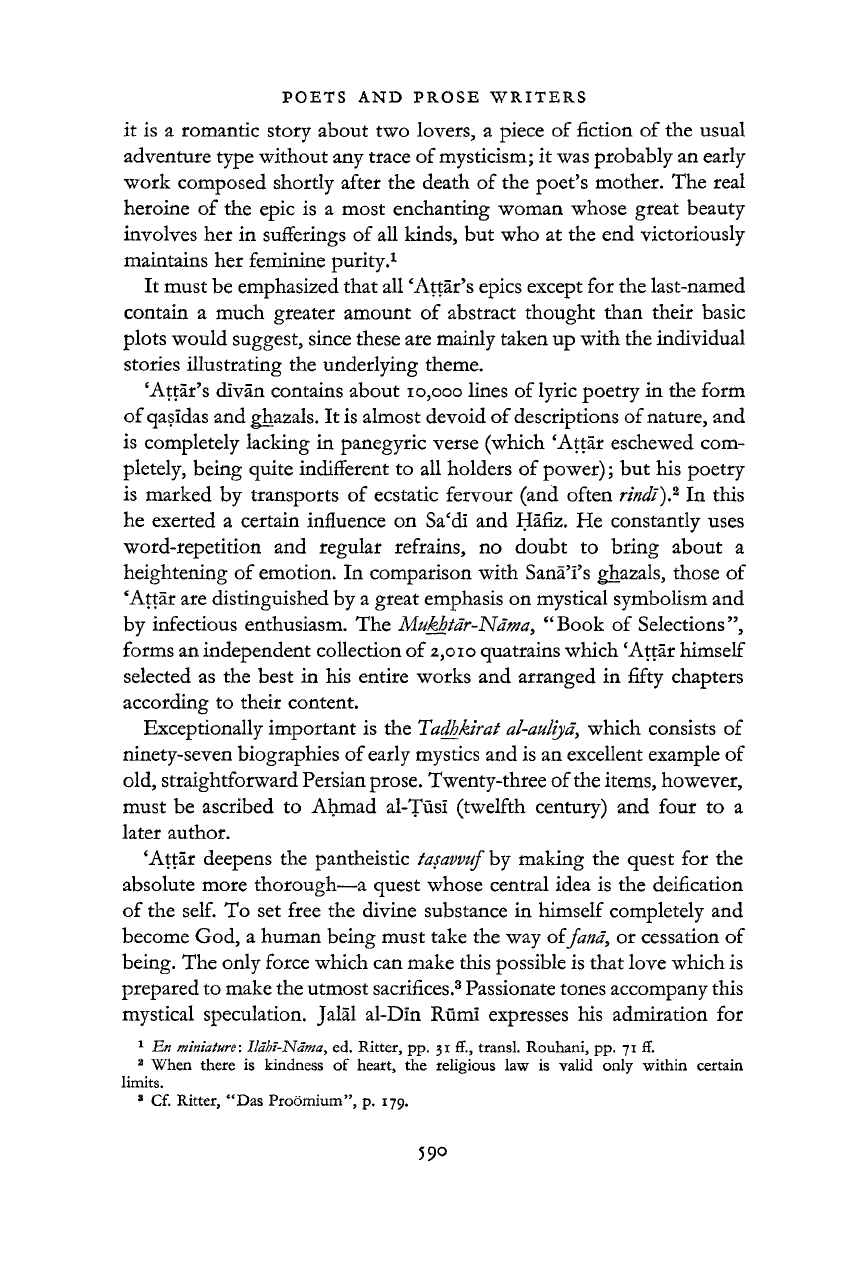
POETS
AND
PROSE WRITERS
590
it
is a
romantic story about
two
lovers,
a
piece
of
fiction
of
the usual
adventure type without any trace
of
mysticism;
it
was probably an early
work composed shortly after
the
death
of
the poet's mother.
The
real
heroine
of the
epic
is a
most enchanting woman whose great beauty
involves
her in
sufferings
of
all kinds,
but who at the end
victoriously
maintains
her
feminine purity.
1
It must
be
emphasized that all 'Attar's epics except
for
the last-named
contain
a
much greater amount
of
abstract thought than their basic
plots would suggest, since these are mainly taken
up
with the individual
stories illustrating
the
underlying theme.
'Attar's divan contains about 10,000 lines
of
lyric poetry
in the
form
of qasidas and
ghazals.
It is
almost devoid
of
descriptions
of
nature,
and
is completely lacking
in
panegyric verse (which 'Attar eschewed com-
pletely, being quite indifferent
to all
holders
of
power);
but his
poetry
is marked
by
transports
of
ecstatic fervour
(and
often
rindl)? In
this
he exerted
a
certain influence
on
Sa'di
and
Háfiz.
He
constantly uses
word-repetition
and
regular refrains,
no
doubt
to
bring about
a
heightening
of
emotion.
In
comparison with Sana'i's ghazals, those
of
'Attar are distinguished
by a
great emphasis
on
mystical symbolism and
by infectious enthusiasm.
The Mukhtár-Náma,
"Book
of
Selections",
forms an independent collection
of
2,010 quatrains which 'Attár himself
selected
as the
best
in his
entire works
and
arranged
in
fifty chapters
according
to
their content.
Exceptionally important
is the Tadhkirat al-auliya,
which consists
of
ninety-seven biographies
of
early mystics and
is an
excellent example
of
old, straightforward Persian prose. Twenty-three of the items, however,
must
be
ascribed
to
Ahmad al-Tusi (twelfth century)
and
four
to a
later author.
'Attár deepens
the
pantheistic
tasavvuf by
making
the
quest
for the
absolute more thorough—a quest whose central idea
is the
deification
of the
self.
To set
free
the
divine substance
in
himself completely
and
become God,
a
human being must take
the way offund, or
cessation
of
being.
The
only force which can make this possible
is
that love which
is
prepared
to
make the utmost sacrifices.
3
Passionate tones accompany this
mystical speculation. Jalál al-Dln Rumi expresses
his
admiration
for
1
En
miniature-.
Iláhi-Náma,
ed.
Ritter,
pp. 31 ff.,
transl. Rouhaní,
pp. 71 f£
2
When there
is
kindness
of
heart,
the
religious
law is
valid only within certain
limits.
8
Cf.
Ritter,
"Das
Proómium",
p. 179.
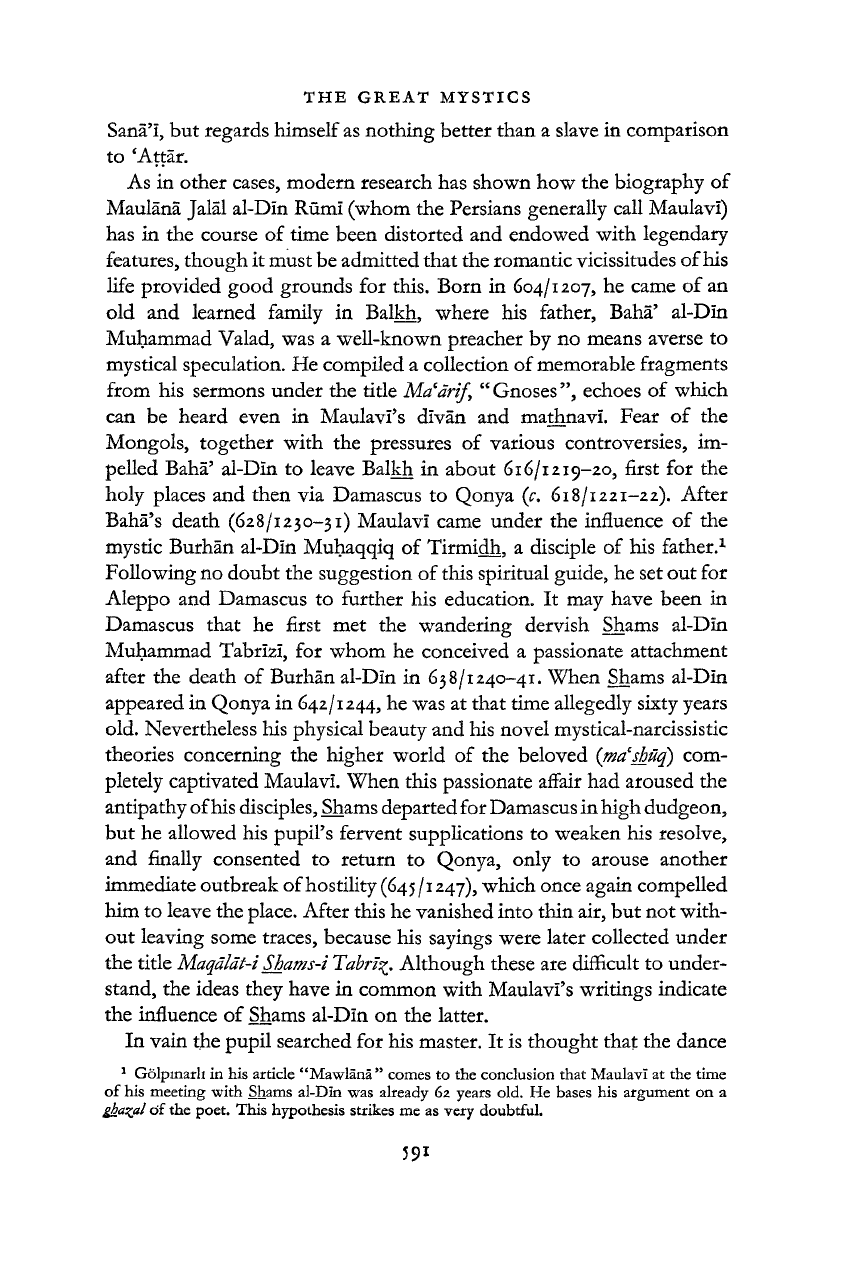
THE GREAT MYSTICS
Sanâ'I,
but
regards himself as nothing better than
a
slave
in
comparison
to 'Attar.
As
in
other cases, modern research
has
shown
how the
biography
of
Maulânâ Jalâl al-Din Rûmi (whom
the
Persians generally call Maulavi)
has
in the
course
of
time been distorted
and
endowed with legendary
features, though
it
must be admitted that the romantic vicissitudes of his
life provided good grounds
for
this. Born
in
604/1207,
he
came
of an
old
and
learned family
in
Balkh, where
his
father, Bahâ' al-Din
Muhammad Valad,
was a
well-known preacher
by no
means averse
to
mystical speculation.
He
compiled
a
collection
of
memorable fragments
from
his
sermons under
the
title
Ma'arif,
"Gnoses", echoes
of
which
can
be
heard even
in
Maulavi's divân
and
mathnavi. Fear
of the
Mongols, together with
the
pressures
of
various controversies,
im-
pelled Bahâ' al-Din
to
leave Balkh
in
about 616/1219-20, first
for the
holy places
and
then
via
Damascus
to
Qonya
(c.
618/1221-22). After
Bahâ's death (628/1230-31) Maulavi came under
the
influence
of the
mystic Burhan al-Din Muhaqqiq
of
Tirmidh,
a
disciple
of his
father.
1
Following no doubt
the
suggestion
of
this spiritual guide,
he
set out
for
Aleppo
and
Damascus
to
further
his
education.
It may
have been
in
Damascus that
he
first
met the
wandering dervish Shams al-Din
Muhammad Tabriz!,
for
whom
he
conceived
a
passionate attachment
after
the
death
of
Burhan al-Din
in
638/1240-41. When Shams al-Din
appeared
in
Qonya
in
642/1244,
he
was
at
that time allegedly sixty years
old. Nevertheless
his
physical beauty and his novel mystical-narcissistic
theories concerning
the
higher world
of the
beloved
(ma'shuq)
com-
pletely captivated Maulavi. When this passionate affair
had
aroused
the
antipathy ofhis disciples, Shams departed for Damascus in high dudgeon,
but
he
allowed
his
pupil's fervent supplications
to
weaken
his
resolve,
and finally consented
to
return
to
Qonya, only
to
arouse another
immediate outbreak of hostility
(645
/1247),
which once again compelled
him
to
leave the place. After this
he
vanished into thin air, but not with-
out leaving some traces, because
his
sayings were later collected under
the title
Maqalat-i Shams-i Tabri^
Although these
are
difficult
to
under-
stand,
the
ideas they have
in
common with Maulavi's writings indicate
the influence
of
Shams al-Din
on the
latter.
In vain
the
pupil searched
for
his master.
It is
thought that
the
dance
1
Gölpınarlı
in
his article "Mawlana" comes
to
the conclusion that Maulavi
at
the time
of his meeting with Shams al-Din
was
already
62
years
old. He
bases
his
argument
on a
ghaçal
of
the poet. This hypothesis strikes me
as
very doubtful.
591
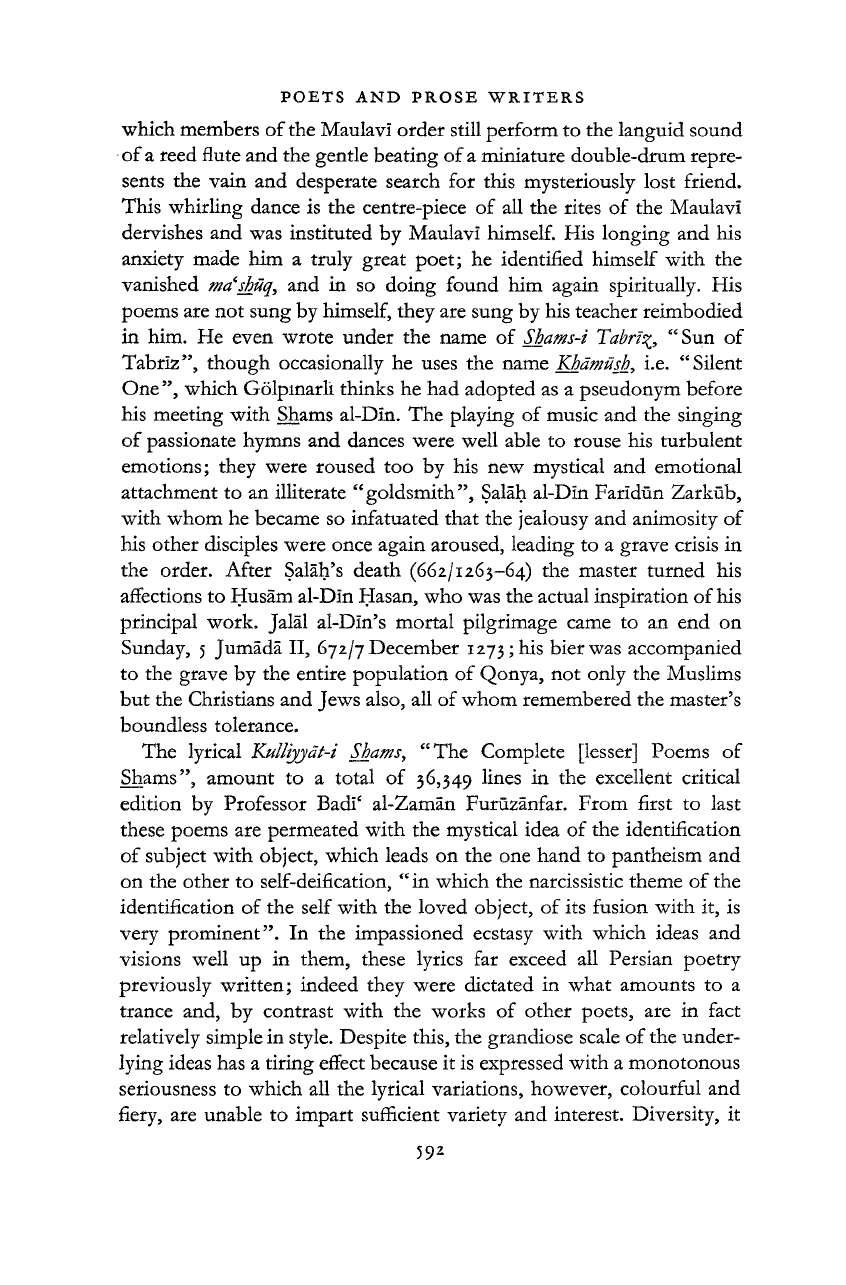
POETS
AND
PROSE WRITERS
592
which members
of
the Maulavi order still perform
to
the languid sound
of a reed flute and
the
gentle beating
of
a miniature double-drum repre-
sents
the
vain
and
desperate search
for
this mysteriously lost friend.
This whirling dance
is the
centre-piece
of all the
rites
of the
Maulavi
dervishes
and was
instituted
by
Maulavi himself.
His
longing
and his
anxiety made
him a
truly great poet;
he
identified himself with
the
vanished
ma
c
shuq, and in so
doing found
him
again spiritually.
His
poems are
not
sung
by
himself, they are sung
by
his teacher reimbodied
in
him. He
even wrote under
the
name
of Shams-i Tabri^ "Sun of
Tabriz", though occasionally
he
uses
the
name
Khdmush, i.e.
"Silent
One", which Golpinarli thinks
he had
adopted
as a
pseudonym before
his meeting with Shams al-Din.
The
playing
of
music
and the
singing
of passionate hymns
and
dances were well able
to
rouse
his
turbulent
emotions; they were roused
too by his new
mystical
and
emotional
attachment
to an
illiterate "goldsmith", Salah al-Din Faridun Zarkub,
with whom
he
became
so
infatuated that
the
jealousy
and
animosity
of
his other disciples were once again aroused, leading
to a
grave crisis
in
the order. After Salah's death (662/1263-64)
the
master turned
his
affections
to
Husam al-Din Hasan,
who
was
the
actual inspiration
of
his
principal work. Jalal al-Din's mortal pilgrimage came
to an end on
Sunday,
5
Jumada
II,
672/7 December 1273; his bier was accompanied
to
the
grave
by the
entire population
of
Qonya,
not
only
the
Muslims
but
the
Christians and Jews also,
all of
whom remembered
the
master's
boundless tolerance.
The lyrical
Kulliyjdt-i Shams, "
The Complete [lesser] Poems
of
Shams", amount
to a
total
of
36,349 lines
in the
excellent critical
edition
by
Professor BadT al-Zaman Furuzanfar. From first
to
last
these poems
are
permeated with
the
mystical idea
of the
identification
of subject with object, which leads
on the one
hand
to
pantheism
and
on
the
other
to
self-deification,
"in
which
the
narcissistic theme
of
the
identification
of the
self with
the
loved object,
of
its fusion with
it, is
very prominent".
In the
impassioned ecstasy with which ideas
and
visions well
up in
them, these lyrics
far
exceed
all
Persian poetry
previously written; indeed they were dictated
in
what amounts
to a
trance
and, by
contrast with
the
works
of
other poets,
are in
fact
relatively simple
in
style. Despite this, the grandiose scale
of
the under-
lying ideas has
a
tiring effect because
it is
expressed with
a
monotonous
seriousness
to
which
all the
lyrical variations, however, colourful
and
fiery, are unable
to
impart sufficient variety
and
interest. Diversity,
it
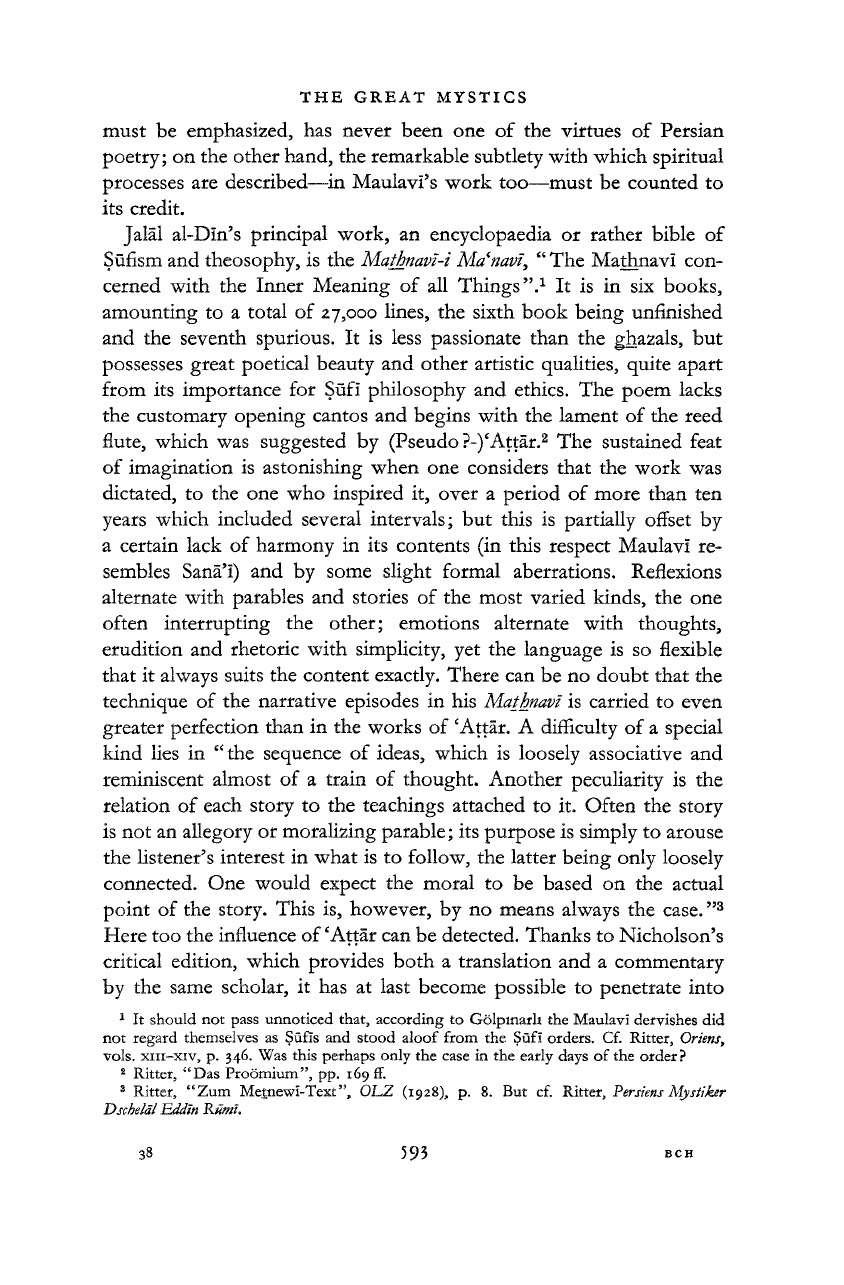
THE GREAT MYSTICS
38
593
BCH
must
be
emphasized,
has
never been
one of the
virtues
of
Persian
poetry;
on the
other hand,
the
remarkable subtlety with which spiritual
processes
are
described—in Maulavi's work too—must
be
counted
to
its credit.
Jalal al-Din's principal work,
an
encyclopaedia
or
rather bible
of
Sufism
and
theosophy,
is the Mathnavi-i Ma'navi, "
The Mathnavi con-
cerned with
the
Inner Meaning
of all
Things".
1
It is in six
books,
amounting
to a
total
of
27,000 lines,
the
sixth book being unfinished
and
the
seventh spurious.
It is
less passionate than
the
ghazals,
but
possesses great poetical beauty
and
other artistic qualities, quite apart
from
its
importance
for
Sufi philosophy
and
ethics.
The
poem lacks
the customary opening cantos
and
begins with
the
lament
of the
reed
flute, which
was
suggested
by
(Pseudo ?-)'Attar.
2
The
sustained feat
of imagination
is
astonishing when
one
considers that
the
work
was
dictated,
to the one who
inspired
it,
over
a
period
of
more than
ten
years which included several intervals;
but
this
is
partially offset
by
a certain lack
of
harmony
in its
contents
(in
this respect Maulavi
re-
sembles Sana'i)
and by
some slight formal aberrations. Reflexions
alternate with parables
and
stories
of the
most varied kinds,
the one
often interrupting
the
other; emotions alternate with thoughts,
erudition
and
rhetoric with simplicity,
yet the
language
is so
flexible
that
it
always suits
the
content exactly. There
can be no
doubt that
the
technique
of the
narrative episodes
in his Mathnavi is
carried
to
even
greater perfection than
in the
works
of
c
Attar.
A
difficulty
of a
special
kind lies
in "the
sequence
of
ideas, which
is
loosely associative
and
reminiscent almost
of a
train
of
thought. Another peculiarity
is the
relation
of
each story
to the
teachings attached
to it.
Often
the
story
is
not an
allegory
or
moralizing parable;
its
purpose
is
simply
to
arouse
the listener's interest
in
what
is to
follow,
the
latter being only loosely
connected.
One
would expect
the
moral
to be
based
on the
actual
point
of the
story. This
is,
however,
by no
means always
the
case.
"
3
Here
too the
influence of'Attar can
be
detected. Thanks
to
Nicholson's
critical edition, which provides both
a
translation
and a
commentary
by
the
same scholar,
it has at
last become possible
to
penetrate into
1
It
should
not
pass unnoticed that, according
to
Golpinarli the Maulavi dervishes
did
not regard themselves
as
Sufis
and
stood aloof from
the
Sufi orders.
Cf.
Ritter, Oriens,
vols,
XIII-XIV,
p. 346. Was this perhaps only the case in the early days of the order ?
2
Ritter,
"Das
Proomium", pp.
169 ff.
3
Ritter,
"Zum
Metnewi-TextOLZ (1928),
p. 8. But cf.
Ritter, Persiens Mystiher
Dscbeldl Eddm Kumu
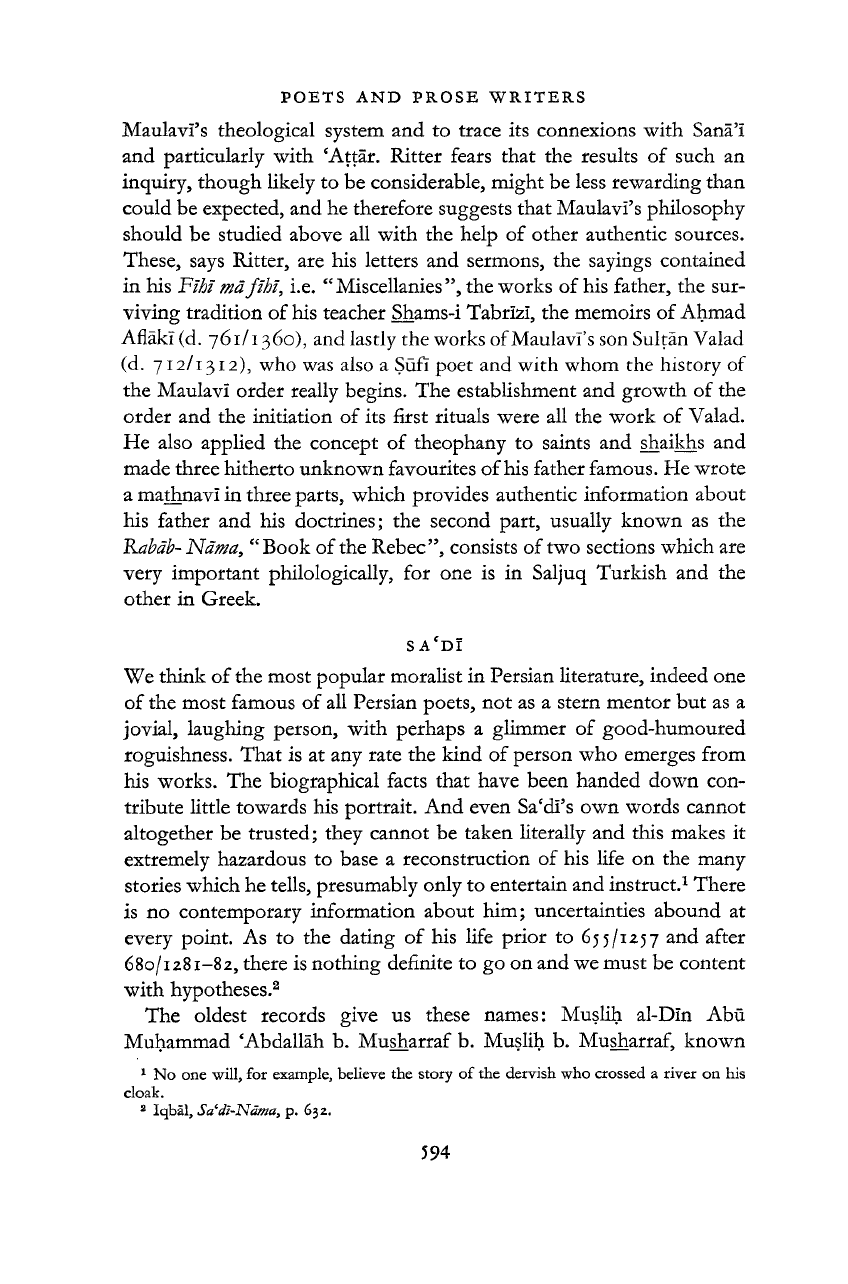
POETS
AND
PROSE WRITERS
594
Maulavf s theological system
and to
trace
its
connexions with Sana'!
and particularly with 'Attar. Ritter fears that
the
results
of
such
an
inquiry, though likely
to be
considerable, might
be
less rewarding than
could
be
expected, and
he
therefore suggests that Maulavf s philosophy
should
be
studied above
all
with
the
help
of
other authentic sources.
These, says Ritter,
are his
letters
and
sermons,
the
sayings contained
in
his
Fih։
ma
f։hi
9
i.e. "
Miscellanies the works
of
his father,
the
sur-
viving tradition
of
his teacher Shams-i Tabriz!,
the
memoirs
of
Ahmad
Aflakl (d. 761/1360), and lastly the works of Maulavf s son Sultan Valad
(d. 712/1312),
who was
also
a
Sufi poet
and
with whom
the
history
of
the Maulavi order really begins.
The
establishment
and
growth
of the
order
and the
initiation
of its
first rituals were
all the
work
of
Valad.
He also applied
the
concept
of
theophany
to
saints
and
shaikhs
and
made three hitherto unknown favourites
of
his father famous.
He
wrote
a mathnavi
in
three parts, which provides authentic information about
his father
and his
doctrines;
the
second part, usually known
as the
Rabdb- Ndma,
"Book
of
the Rebec", consists
of
two sections which
are
very important philologically,
for one is in
Saljuq Turkish
and the
other
in
Greek.
s A'DI
We think
of
the most popular moralist
in
Persian literature, indeed
one
of the most famous
of
all Persian poets,
not as a
stern mentor
but as a
jovial, laughing person, with perhaps
a
glimmer
of
good-humoured
roguishness. That
is at any
rate
the
kind
of
person
who
emerges from
his works.
The
biographical facts that have been handed down con-
tribute little towards
his
portrait.
And
even Sa'df s
own
words cannot
altogether
be
trusted; they cannot
be
taken literally
and
this makes
it
extremely hazardous
to
base
a
reconstruction
of his
life
on the
many
stories which
he
tells, presumably only
to
entertain and instruct.
1
There
is
no
contemporary information about
him;
uncertainties abound
at
every point.
As to the
dating
of his
life prior
to
655/1257
and
after
680/1281-82, there
is
nothing definite
to go on
and
we
must
be
content
with hypotheses.
2
The oldest records give
us
these names: Muslih al-Din
Abu
Muhammad 'Abdallah
b.
Musharraf
b.
Muslih
b.
Musharraf, known
1
No
one will,
for
example, believe
the
story
of
the dervish who crossed
a
river
on his
cloak.
2
Iqbal, Sctdi-Nama,
p. 632.
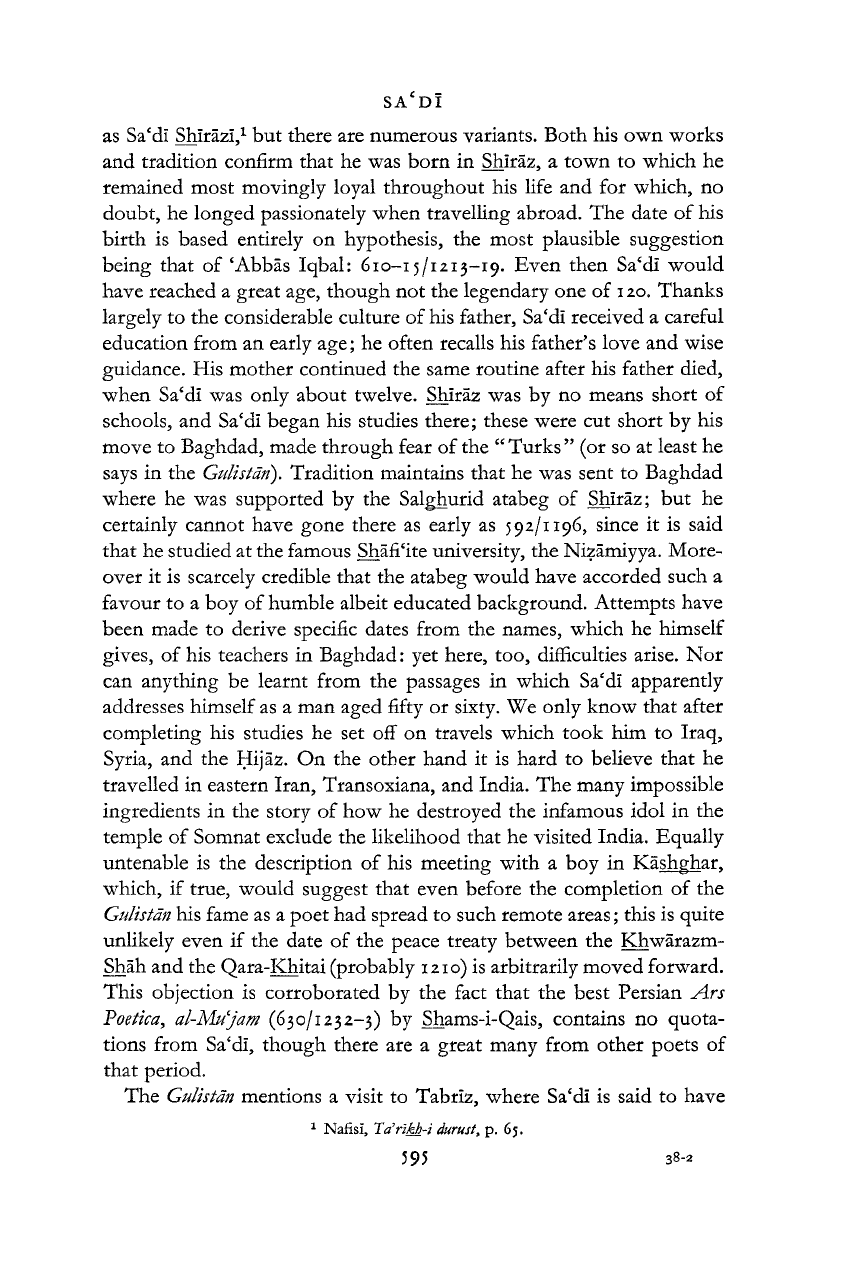
SA'DÎ
as Sa'di Şhırâzı,
1
but
there
are
numerous variants. Both
his own
works
and tradition confirm that
he was
born
in
Shiraz,
a
town
to
which
he
remained most movingly loyal throughout
his
life
and for
which,
no
doubt,
he
longed passionately when travelling abroad.
The
date
of his
birth
is
based entirely
on
hypothesis,
the
most plausible suggestion
being that
of
'Abbas Iqbal: 610-15/1213-19. Even then Sa'di would
have reached
a
great age, though
not the
legendary
one of
120. Thanks
largely
to the
considerable culture
of
his father, Sa'di received
a
careful
education from
an
early age;
he
often recalls
his
father's love
and
wise
guidance.
His
mother continued
the
same routine after
his
father died,
when Sa'di
was
only about twelve. Shirâz
was by no
means short
of
schools,
and
Sa'di began
his
studies there; these were
cut
short
by his
move
to
Baghdad, made through fear
of
the
"
Turks
" (or so at
least
he
says
in the Gülistan).
Tradition maintains that
he was
sent
to
Baghdad
where
he was
supported
by the
Salghurid atabeg
of
Şhîrâz;
but he
certainly cannot have gone there
as
early
as
592/1196, since
it is
said
that
he
studied
at
the famous Shâfi'ite university,
the
Nizâmiyya. More-
over
it is
scarcely credible that
the
atabeg would have accorded such
a
favour
to a boy of
humble albeit educated background. Attempts have
been made
to
derive specific dates from
the
names, which
he
himself
gives,
of
his teachers
in
Baghdad:
yet
here,
too,
difficulties arise.
Nor
can anything
be
learnt from
the
passages
in
which Sa'di apparently
addresses himself as
a
man aged fifty
or
sixty.
We
only know that after
completing
his
studies
he set off on
travels which took
him to
Iraq,
Syria,
and the
Hijâz.
On the
other hand
it is
hard
to
believe that
he
travelled
in
eastern Iran, Transoxiana,
and
India.
The
many impossible
ingredients
in the
story
of how he
destroyed
the
infamous idol
in the
temple
of
Somnat exclude
the
likelihood that
he
visited India. Equally
untenable
is the
description
of his
meeting with
a boy in
Kâshghar,
which,
if
true, would suggest that even before
the
completion
of the
Gülistan
his fame
as a
poet had spread
to
such remote areas; this
is
quite
unlikely even
if the
date
of the
peace treaty between
the
Khwarazm-
Shâh and
the
Qara-Khitai (probably 1210)
is
arbitrarily moved forward.
This objection
is
corroborated
by the
fact that
the
best Persian
Ars
Poetica,
al-Mu
c
jam
(630/1232-3)
by
Shams-i-Qais, contains
no
quota-
tions from Sa'di, though there
are a
great many from other poets
of
that period.
The
Gülistan
mentions
a
visit
to
Tabriz, where Sa'di
is
said
to
have
1
Nafisî, Ta'rikh-i
durust.
p. 65.
595
38-2
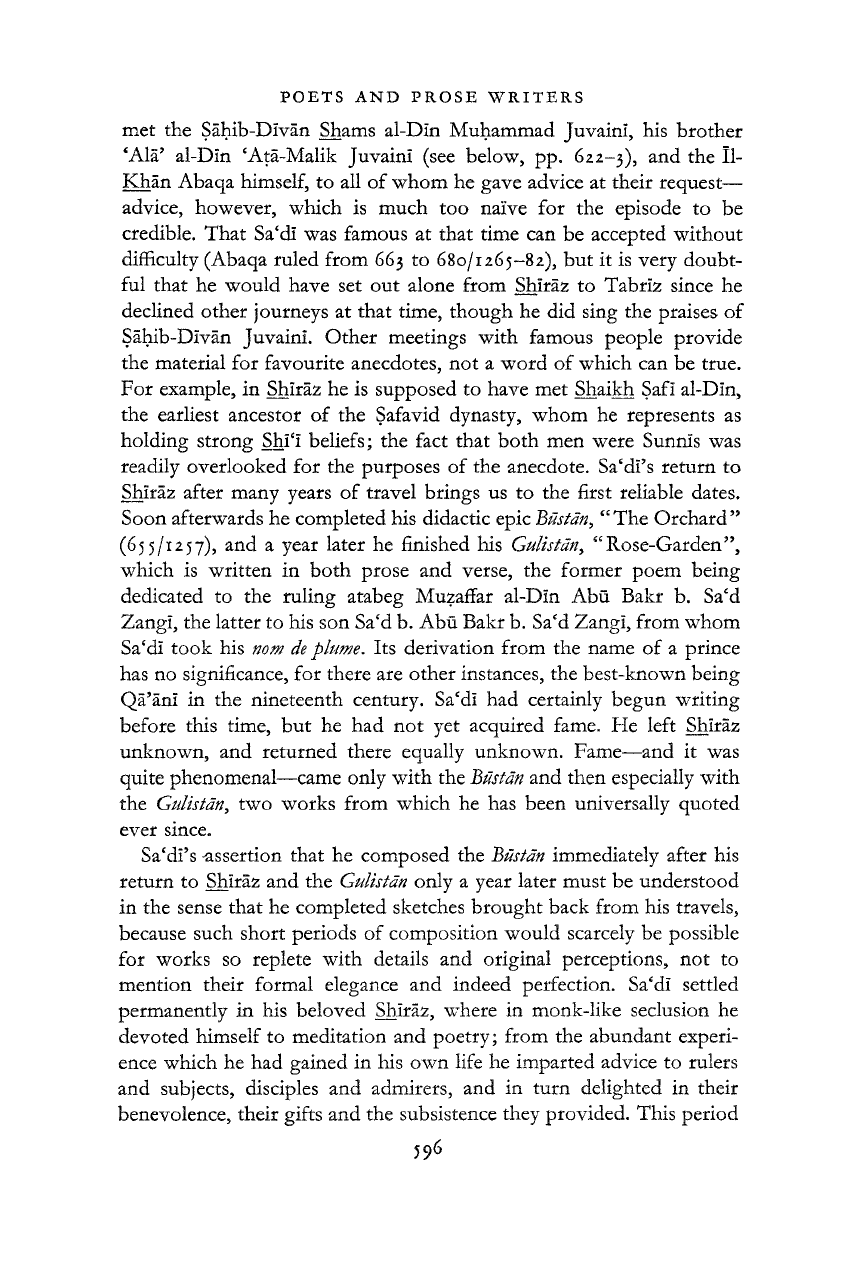
POETS
AND
PROSE WRITERS
596
met
the
Sahib-Divan Shams al-Din Muhammad Juvaini,
his
brother
'Ala' al-Din 'Ata-Malik Juvaini
(see
below,
pp.
622-3),
and the II-
Khan Abaqa himself,
to all of
whom
he
gave advice
at
their request—
advice, however, which
is
much
too
naive
for the
episode
to be
credible. That Sa'di
was
famous
at
that time
can be
accepted without
difficulty (Abaqa ruled from 663
to
680/1265-82),
but it is
very doubt-
ful that
he
would have
set out
alone from Shiraz
to
Tabriz since
he
declined other journeys
at
that time, though
he did
sing
the
praises
of
Sahib-Divan Juvaini. Other meetings with famous people provide
the material
for
favourite anecdotes,
not a
word
of
which
can be
true.
For example,
in
Shiraz
he is
supposed
to
have
met
Shaikh Safi al-Din,
the earliest ancestor
of the
Safavid dynasty, whom
he
represents
as
holding strong Shi'i beliefs;
the
fact that both
men
were Sunnis
was
readily overlooked
for the
purposes
of the
anecdote. Sa'di's return
to
Shiraz after many years
of
travel brings
us to the
first reliable dates.
Soon afterwards
he
completed his didactic
epicBustdn,
"The
Orchard"
(655/1257),
and a
year later
he
finished
his Gulistdn,
"Rose-Garden",
which
is
written
in
both prose
and
verse,
the
former poem being
dedicated
to the
ruling atabeg Muzaffar al-Din
Abu.
Bakr
b. Sa'd
Zangi, the latter
to
his
son
Sa'd b. Abu. Bakr b. Sa'd Zangi, from whom
Sa'di took
his nom de plume. Its
derivation from
the
name
of a
prince
has
no
significance,
for
there
are
other instances,
the
best-known being
Qa'ani
in the
nineteenth century. Sa'di
had
certainly begun writing
before this time,
but he had not yet
acquired fame.
He
left Shiraz
unknown,
and
returned there equally unknown. Fame—and
it was
quite phenomenal—came only with the
Bustdn and
then especially with
the
Gulistdn, two
works from which
he has
been universally quoted
ever since.
Sa'di's -assertion that
he
composed
the Bustdn
immediately after
his
return
to
Shiraz
and the Gulistdn
only
a
year later must
be
understood
in
the
sense that
he
completed sketches brought back from
his
travels,
because such short periods
of
composition would scarcely
be
possible
for works
so
replete with details
and
original perceptions,
not to
mention their formal elegance
and
indeed perfection. Sa'di settled
permanently
in his
beloved Shiraz, where
in
monk-like seclusion
he
devoted himself
to
meditation
and
poetry; from
the
abundant experi-
ence which
he had
gained
in his own
life
he
imparted advice
to
rulers
and subjects, disciples
and
admirers,
and in
turn delighted
in
their
benevolence, their gifts
and the
subsistence they provided. This period
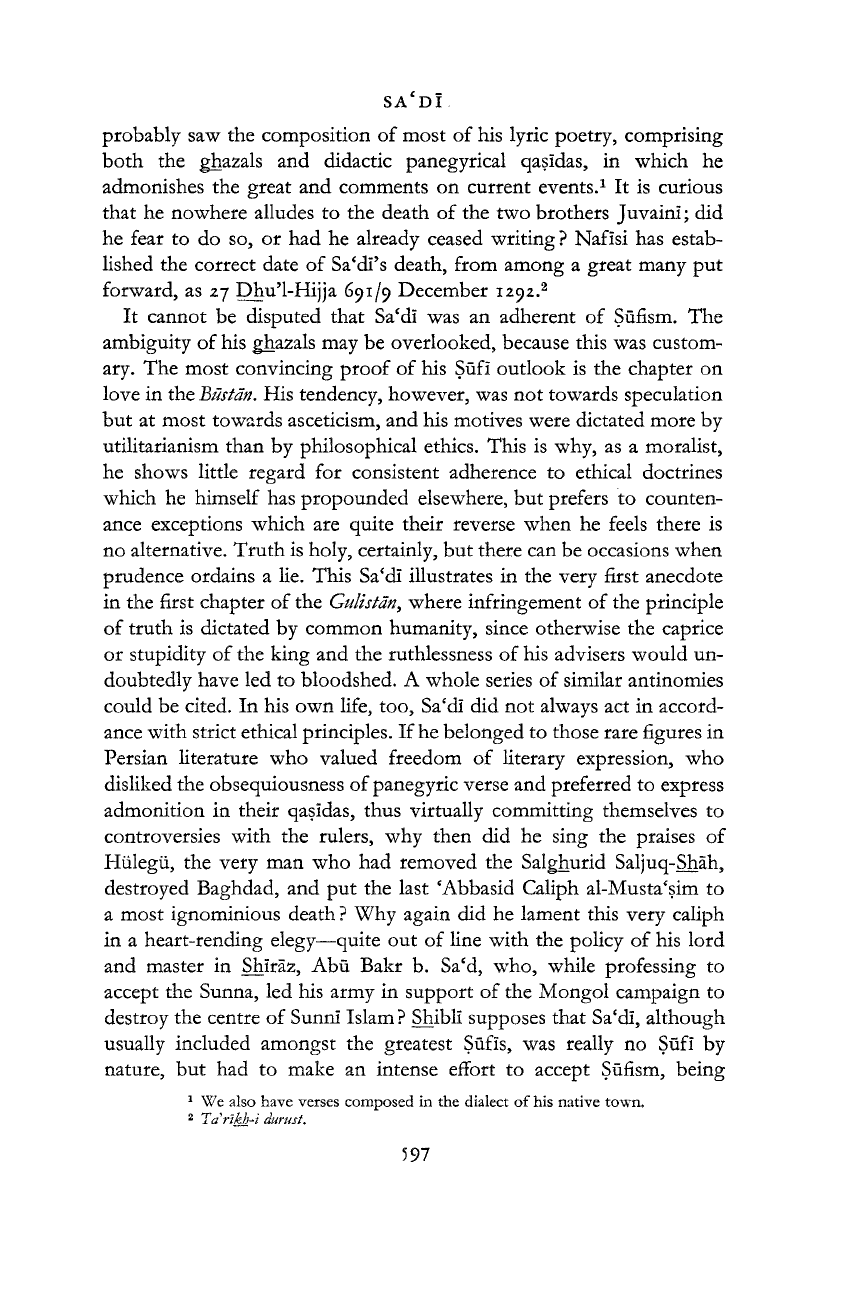
SA'DI
597
probably
saw the
composition
of
most
of
his lyric poetry, comprising
both
the
ghazals
and
didactic panegyrical qasidas,
in
which
he
admonishes
the
great
and
comments
on
current events.
1
It is
curious
that
he
nowhere alludes
to the
death
of the two
brothers Juvaini;
did
he fear
to do so, or had he
already ceased writing
?
Nafisi
has
estab-
lished
the
correct date
of
Sa'dTs death, from among
a
great many
put
forward,
as 27
Dhu'l-Hijja 691/9 December 1292.
2
It cannot
be
disputed that Sa'di
was an
adherent
of
Sufism.
The
ambiguity
of
his ghazals
may be
overlooked, because this
was
custom-
ary.
The
most convincing proof
of his
Sufi outlook
is the
chapter
on
love
in
the
Bustdn. His
tendency, however,
was not
towards speculation
but
at
most towards asceticism, and his motives were dictated more
by
utilitarianism than
by
philosophical ethics. This
is why, as a
moralist,
he shows little regard
for
consistent adherence
to
ethical doctrines
which
he
himself
has
propounded elsewhere,
but
prefers
to
counten-
ance exceptions which
are
quite their reverse when
he
feels there
is
no alternative. Truth
is
holy, certainly,
but
there can
be
occasions when
prudence ordains
a lie.
This Sa'di illustrates
in the
very first anecdote
in
the
first chapter
of
the
Gulistdn^
where infringement
of
the principle
of truth
is
dictated
by
common humanity, since otherwise
the
caprice
or stupidity
of
the king
and the
ruthlessness
of
his advisers would
un-
doubtedly have
led to
bloodshed.
A
whole series
of
similar antinomies
could
be
cited.
In his own
life,
too,
Sa'di
did not
always
act in
accord-
ance with strict ethical principles.
If
he belonged
to
those rare figures
in
Persian literature
who
valued freedom
of
literary expression,
who
disliked
the
obsequiousness
of
panegyric verse
and
preferred
to
express
admonition
in
their qasidas, thus virtually committing themselves
to
controversies with
the
rulers,
why
then
did he
sing
the
praises
of
Hiilegii,
the
very
man who had
removed
the
Salghurid Saljuq-Shah,
destroyed Baghdad,
and put the
last 'Abbasid Caliph al-Musta'sim
to
a most ignominious death
?
Why
again
did he
lament this very caliph
in
a
heart-rending elegy—quite
out of
line with
the
policy
of his
lord
and master
in
Shiraz,
Abu.
Bakr
b. Sa'd, who,
while professing
to
accept
the
Sunna,
led his
army
in
support
of the
Mongol campaign
to
destroy
the
centre
of
Sunni Islam
?
Shibli supposes that Sa'di, although
usually included amongst
the
greatest Sufis,
was
really
no
Sufi
by
nature,
but had to
make
an
intense effort
to
accept Sufism, being
1
We
also have verses composed
in the
dialect
of
his native town.
2
Tarikh-i
durust.
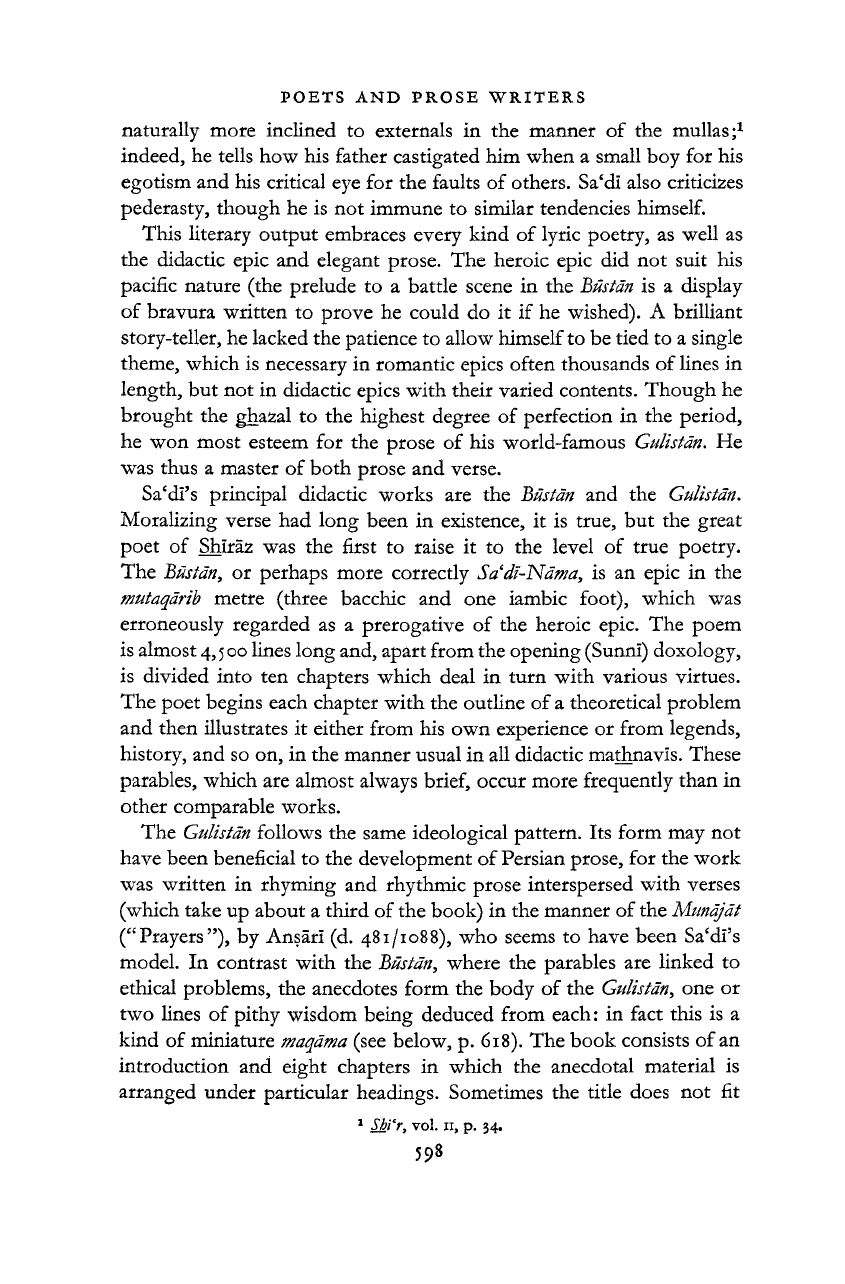
POETS
AND
PROSE WRITERS
naturally more inclined
to
externals
in the
manner
of the
mullas;
1
indeed,
he
tells
how his
father castigated
him
when
a
small
boy for his
egotism
and his
critical
eye for the
faults
of
others. Sa'di also criticizes
pederasty, though
he is not
immune
to
similar tendencies himself.
This literary output embraces every kind
of
lyric poetry,
as
well
as
the didactic epic
and
elegant prose.
The
heroic epic
did not
suit
his
pacific nature
(the
prelude
to a
battle scene
in the Bustdn is a
display
of bravura written
to
prove
he
could
do it if he
wished).
A
brilliant
story-teller,
he
lacked
the
patience
to
allow himself to
be
tied
to a
single
theme, which
is
necessary
in
romantic epics often thousands
of
lines
in
length,
but not in
didactic epics with their varied contents. Though
he
brought
the
ghazal
to the
highest degree
of
perfection
in the
period,
he
won
most esteem
for the
prose
of his
world-famous
Gulistdn. He
was thus
a
master
of
both prose
and
verse.
Sa'di's principal didactic works
are the Bustdn and the Gulistdn.
Moralizing verse
had
long been
in
existence,
it is
true,
but the
great
poet
of
Shiraz
was the
first
to
raise
it to the
level
of
true poetry.
The
Bustdn, or
perhaps more correctly
Sa'di-Ndma, is an
epic
in the
mutaqdrib
metre (three bacchic
and one
iambic foot), which
was
erroneously regarded
as a
prerogative
of the
heroic epic.
The
poem
is almost 4,500 lines long and, apart from the opening (Sunni) doxology,
is divided into
ten
chapters which deal
in
turn with various virtues.
The poet begins each chapter with
the
outline
of a
theoretical problem
and then illustrates
it
either from
his own
experience
or
from legends,
history,
and so on, in the
manner usual
in all
didactic mathnavis. These
parables, which
are
almost always
brief,
occur more frequently than
in
other comparable works.
The
Gulistdn
follows
the
same ideological pattern.
Its
form
may not
have been beneficial
to the
development
of
Persian prose,
for the
work
was written
in
rhyming
and
rhythmic prose interspersed with verses
(which take
up
about
a
third
of
the book)
in the
manner
of
the
Mundjdt
("Prayers"),
by
Ansari
(d.
481/1088),
who
seems
to
have been Sa'di's
model.
In
contrast with
the Bustdn,
where
the
parables
are
linked
to
ethical problems,
the
anecdotes form
the
body
of the Gulistdn, one or
two lines
of
pithy wisdom being deduced from each:
in
fact this
is a
kind
of
miniature
maqdma (see
below,
p.
618).
The
book consists
of
an
introduction
and
eight chapters
in
which
the
anecdotal material
is
arranged under particular headings. Sometimes
the
title does
not fit
1
Sii'r,
vol.
11,
p.
34·
598
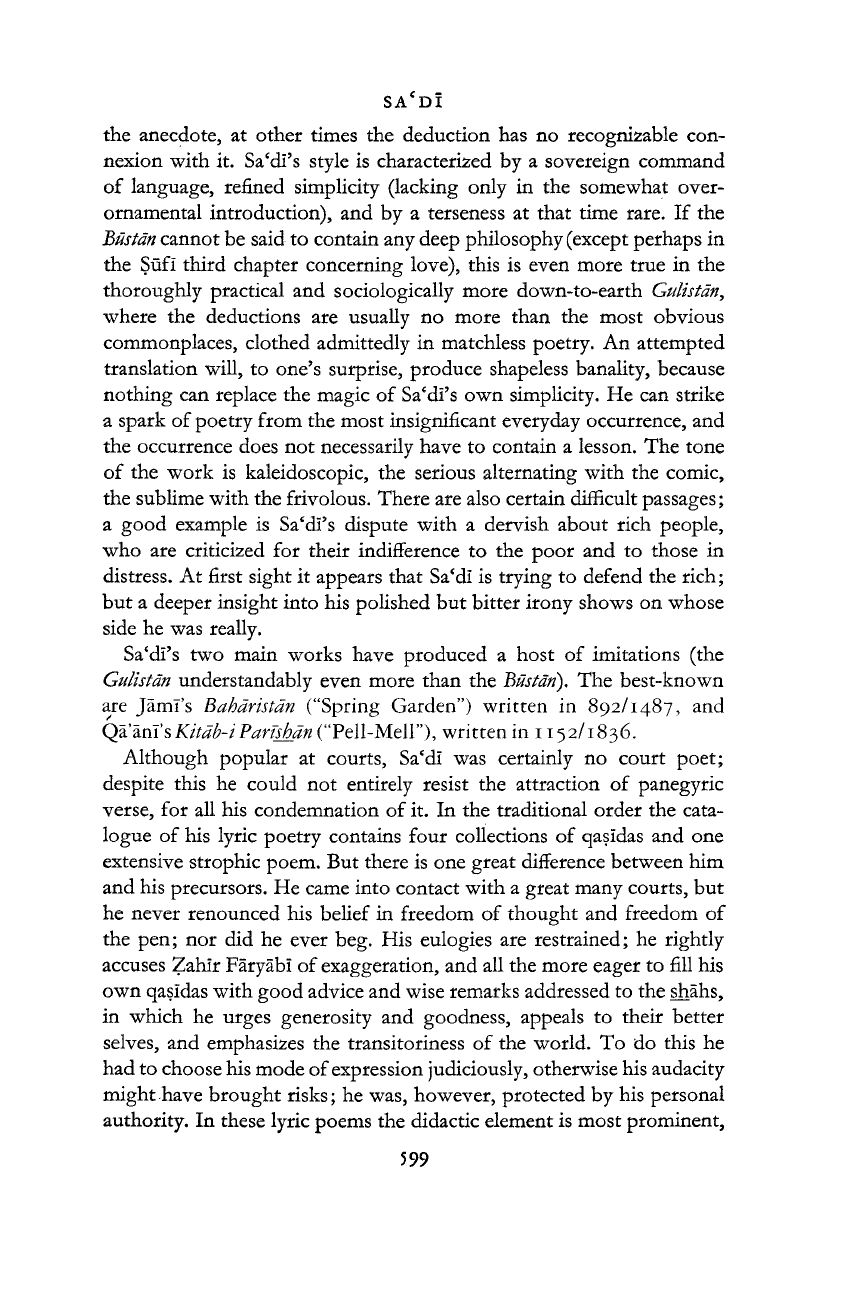
SA'DÏ
the anecdote,
at
other times
the
deduction
has no
recognizable con-
nexion with
it.
Sa'di's style
is
characterized
by a
sovereign command
of language, refined simplicity (lacking only
in the
somewhat over-
ornamental introduction),
and by a
terseness
at
that time rare.
If the
Büstdn
cannot
be
said
to
contain
any
deep philosophy (except perhaps
in
the Süfi third chapter concerning love), this
is
even more true
in the
thoroughly practical
and
sociologically more down-to-earth
Gulistan,
where
the
deductions
are
usually
no
more than
the
most obvious
commonplaces, clothed admittedly
in
matchless poetry.
An
attempted
translation will,
to
one's surprise, produce shapeless banality, because
nothing
can
replace
the
magic
of
Sa'di's
own
simplicity.
He can
strike
a spark
of
poetry from
the
most insignificant everyday occurrence,
and
the occurrence does
not
necessarily have
to
contain
a
lesson.
The
tone
of
the
work
is
kaleidoscopic,
the
serious alternating with
the
comic,
the sublime with
the
frivolous. There
are
also certain difficult passages;
a good example
is
Sa'di's dispute with
a
dervish about rich people,
who
are
criticized
for
their indifference
to the
poor
and to
those
in
distress.
At
first sight
it
appears that Sa'di
is
trying
to
defend
the
rich;
but
a
deeper insight into
his
polished
but
bitter irony shows
on
whose
side
he was
really.
Sa
c
di's
two
main works have produced
a
host
of
imitations
(the
Gulistdn
understandably even more than
the Büstdn). The
best-known
are Jàmf s
Bahdristdn
("Spring Garden") written
in
892/1487,
and
Qà'anï's
Kitdb֊iParïsh_àn
("Pell-Mell"), written
in
1152/1836.
Although popular
at
courts, Sa
c
di
was
certainly
no
court poet;
despite this
he
could
not
entirely resist
the
attraction
of
panegyric
verse,
for all his
condemnation
of
it.
In the
traditional order
the
cata-
logue
of his
lyric poetry contains four collections
of
qasidas
and one
extensive strophic poem.
But
there
is one
great difference between
him
and
his
precursors.
He
came into contact with
a
great many courts,
but
he never renounced
his
belief
in
freedom
of
thought
and
freedom
of
the
pen; nor did he
ever
beg. His
eulogies
are
restrained;
he
rightly
accuses Zahir Faryabi
of
exaggeration,
and all the
more eager
to
fill
his
own qasidas with good advice and wise remarks addressed
to the
shahs,
in which
he
urges generosity
and
goodness, appeals
to
their better
selves,
and
emphasizes
the
transitoriness
of the
world.
To do
this
he
had
to
choose his mode of expression judiciously, otherwise his audacity
might have brought risks;
he
was, however, protected
by his
personal
authority.
In
these lyric poems
the
didactic element
is
most prominent,
599
